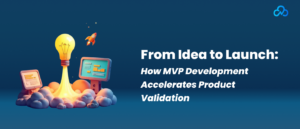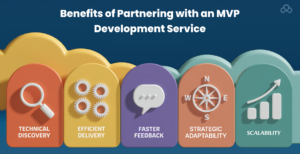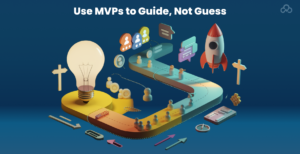From Idea to Launch: How MVP Development Accelerates Product Validation

You’ve got a product idea. Maybe it came to you in the middle of a work sprint, or maybe it’s been sitting in a notebook for months. Either way, the next step seems obvious: build it. But then the questions start. Do people actually want this? Will they pay for it? How long will it take? How much will it cost? And that’s where most startups stall. Caught between momentum and uncertainty. Here’s the thing, building everything at once is rarely the answer. That’s why more teams are leaning on something called an agile development MVP. It’s not about launching fast just to say you did. It’s about launching lean, learning quickly, and finding out, before it’s too late, if you’re building the right thing at all.
If you’ve got limited resources (and let’s be honest, most of us do), this isn’t optional anymore. It’s essential.
Understanding Agile Development MVP
Let’s strip the jargon for a second.
You’ll hear a lot of definitions about MVPs, “a minimal version of a product,” “something that delivers core value,” “the first usable release”, and technically, they’re all true.
But in an agile workflow and during the agile development MVP, an MVP isn’t a phase, it’s a rhythm. You don’t just build something once and hope. You build a little, test a little, adjust, then repeat.
Each sprint becomes an experiment: What’s the next smallest thing we can ship that gives us more certainty?
Here’s what that looks like in practice:
-
Your backlog gets trimmed down to one core idea.
-
You build that idea with the simplest possible implementation.
-
You hand it to users, not your friends, not your team, but real users, and you listen.
That’s the heartbeat of agile development MVP work.
And if you decide to develop custom MVP product software using this approach, you’re not cutting corners, you’re building something that grows with you. Something that actually reflects how people use your product, not how you imagined they would.
Why MVP Development Accelerates Product Validation
Validation sounds like a buzzword, but it’s really just this: proof that what you’re building is worth building.
And MVPs help you get that proof faster.
Let’s say you’ve got six features on your roadmap. In a traditional dev process, you’d build them all, launch them, then wait for feedback. But with an MVP? You might ship just one feature, maybe even less. And within a week, you’ll know whether anyone actually uses it.
Here’s why that matters:
- Real behavior beats assumptions.
What users say isn’t always what they do. MVPs give you data you can trust, based on actions, not opinions.
- You avoid polishing features no one needs.
Instead of tweaking screens endlessly, you focus on what gets used. Nothing else.
- You save time and money.
The cost to develop MVP software is much lower than rebuilding a bloated product that missed the mark.
- You give your team breathing room.
When you build in small, focused loops, you avoid burnout, and the pressure to “get it right” the first time.
A real-world detour: A startup we spoke to last year planned to launch a full financial dashboard. But after testing their MVP with just one feature, expense tracking, they found 80% of users only used that one tool. So they threw out the rest. And got to market three months earlier.
That’s what agile development MVPs give you: clarity. And in early-stage product development, clarity is leverage.
Agile MVP in Action: Development Workflow
An agile development MVP doesn’t begin with a fully defined feature set. Instead, it starts with a hypothesis: this feature might solve this problem. From there, each sprint becomes a structured experiment to test that assumption.
Here’s how agile development MVP teams typically structure MVP development:
|
Phase |
Goal |
Output |
|
Discovery & Planning |
Clarify the problem and define core value |
Product backlog with MVP priorities |
|
Sprint 0 (Design) |
Build low-fidelity wireframes and basic flows |
Clickable mockups |
|
Sprint 1–2 (Core Build) |
Build the minimal feature set that delivers value |
Working MVP version |
|
Sprint 3 (Feedback) |
Deploy to early users and capture behavior data |
Usage analytics, feedback log |
|
Sprint 4+ (Iteration) |
Improve based on data and refine product direction |
Enhanced functionality or pivot |
In this framework, every decision, design, code, or UX, is guided by user validation and product goals, not guesswork. This is why teams that develop custom MVP software within an agile model typically reduce waste and reach product-market fit faster.
The True Cost to Develop MVP Software
One of the most common questions for early-stage teams is: How much does it cost to develop an MVP?
The answer depends on a range of factors: team size, tech stack, complexity, and whether you’re using internal resources or a professional MVP development service.
Here’s a breakdown based on recent industry benchmarks:
|
MVP Type |
Estimated Cost (USD) |
Recommended Use Case |
|
No-code / low-code MVP |
$5,000 – $15,000 |
Quick validation, simple workflows |
|
Hybrid MVP (some custom logic) |
$15,000 – $35,000 |
Moderate complexity, API integrations |
|
Full custom MVP software |
$35,000 – $75,000+ |
Scalable architecture, long-term use |
Naturally, the cost to develop MVP software increases with scope and customization. However, what matters more than the number is what you get in return, a validated product path, early traction, and reduced technical debt later on.
When to Develop Custom MVP Software vs Use Lean Alternatives
Not every project requires custom code from day one. But certain use cases strongly benefit from it.
Use custom MVP software when:
-
You need unique business logic or integrations
-
You’re building infrastructure for future scale
-
Security or compliance is a major concern
Use no-code or templates when:
-
You’re testing a landing page or simple concept
-
Speed is more important than precision
-
The MVP will likely be discarded post-validation
|
Project Type |
Recommended MVP Build Type |
|
AI-powered SaaS tool |
Custom MVP Software |
|
B2C lead-gen funnel |
No-code or template |
|
Marketplace MVP |
Hybrid with integrations |
|
Enterprise platform POC |
Full MVP development service |
Working with an experienced agile development mvp service ensures you’re choosing the right path, not just the fastest one.
Benefits of Partnering with an MVP Development Service

Choosing to work with an external team, especially one specialized in MVPs, adds more than just engineering bandwidth.
Here’s what a qualified MVP development service typically brings to the table:
-
Technical discovery: Clear scope, risk identification, and architecture guidance
-
Efficient delivery: Agile frameworks, short sprint cycles, clear accountability
-
Faster feedback: Integration of analytics and feedback tools from day one
-
Strategic adaptability: The ability to pivot quickly based on metrics
-
Scalability: Foundation for long-term product expansion if the MVP succeeds
Founders who develop custom MVP products with the right partners reduce misalignment, ship earlier, and position themselves for better funding conversations or early traction.
Common Mistakes to Avoid
MVP development is deceptively simple. Many startups still fall into these traps:
- Building too much too soon
MVPs are about learning, not impressing. Every unnecessary feature is added risk.
- Ignoring user data
Validation only works if you measure what matters. Use tools like Hotjar, Mixpanel, or GA4 to track behavior.
- Skipping usability testing
Functional doesn’t mean usable. Even lean products need UX validation.
- Failing to iterate post-launch
A good MVP doesn’t end at deployment. Iteration is where the real product begins.
Technical FAQs
Q1: How long does it take to develop an MVP using agile methods?
Typically 4–8 weeks, depending on scope and team experience. An agile MVP development service can often ship faster due to proven workflows.
Q2: What is the cost to develop MVP software with external teams?
For custom builds, expect $35K–$75K+. Simpler MVPs may cost under $20K with no-code tools or hybrid setups.
Q3: Why choose to develop custom MVP software instead of using templates?
Custom MVPs offer scalability, better performance, and control over features, ideal for products you plan to grow long-term.
Q4: What does “agile development MVP” really mean in practice?
It’s a lean, iterative process where the MVP evolves based on short sprints, real feedback, and rapid testing, minimizing risk before major investment.
Use MVPs to Guide, Not Guess

Launching a product isn’t just about execution, it’s about direction. The real value of an agile development MVP lies in what it tells you: what works, what doesn’t, and where to go next. Startups that validate early avoid costly pivots later. They also tend to fundraise more efficiently, retain users better, and grow with fewer dead ends.
If you’re building something ambitious, don’t wait until it’s “ready.” Work with an expert MVP development service, ship something lean, and learn from the people who matter most, your users. Because in today’s product landscape, smart beats fast. And learning beats guessing, every time.
Do you like to read more educational content? Read our blogs at Cloudastra Technologies or contact us for business enquiry at Cloudastra Contact Us